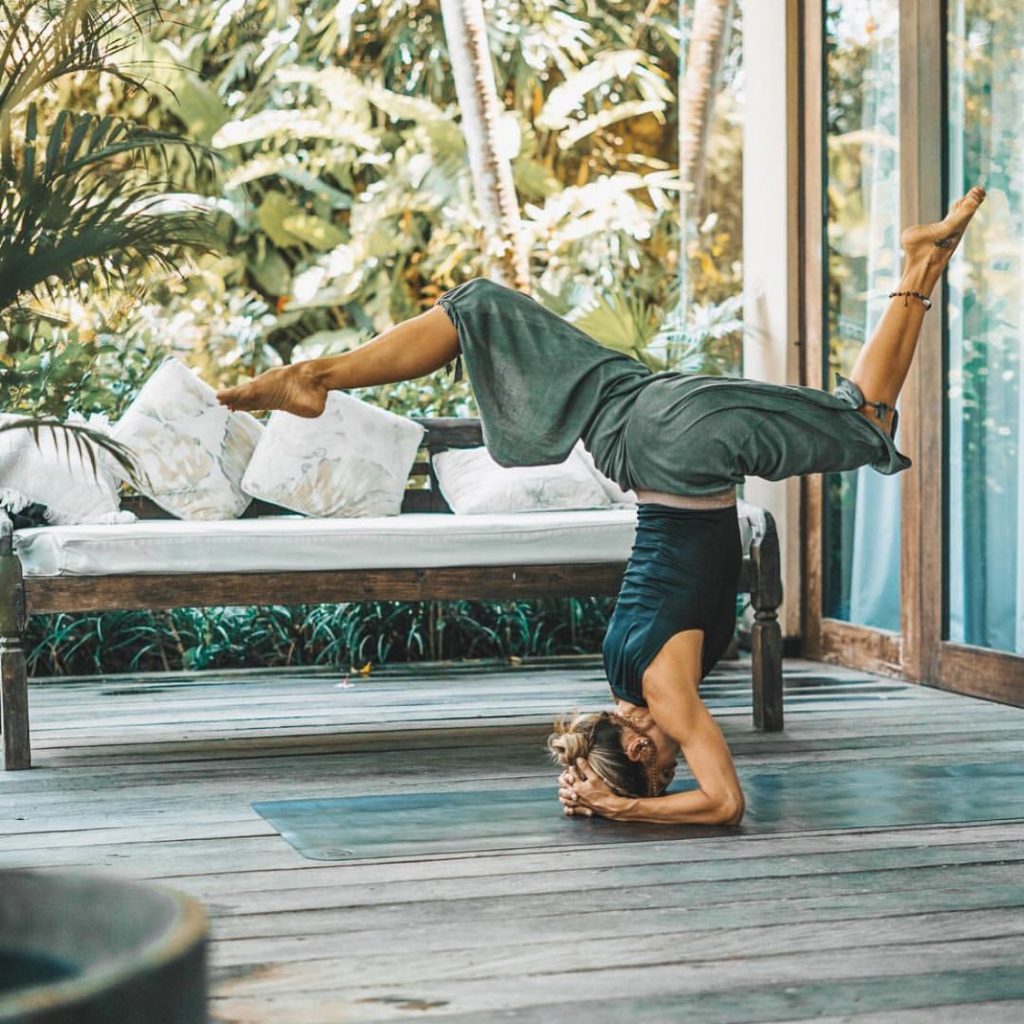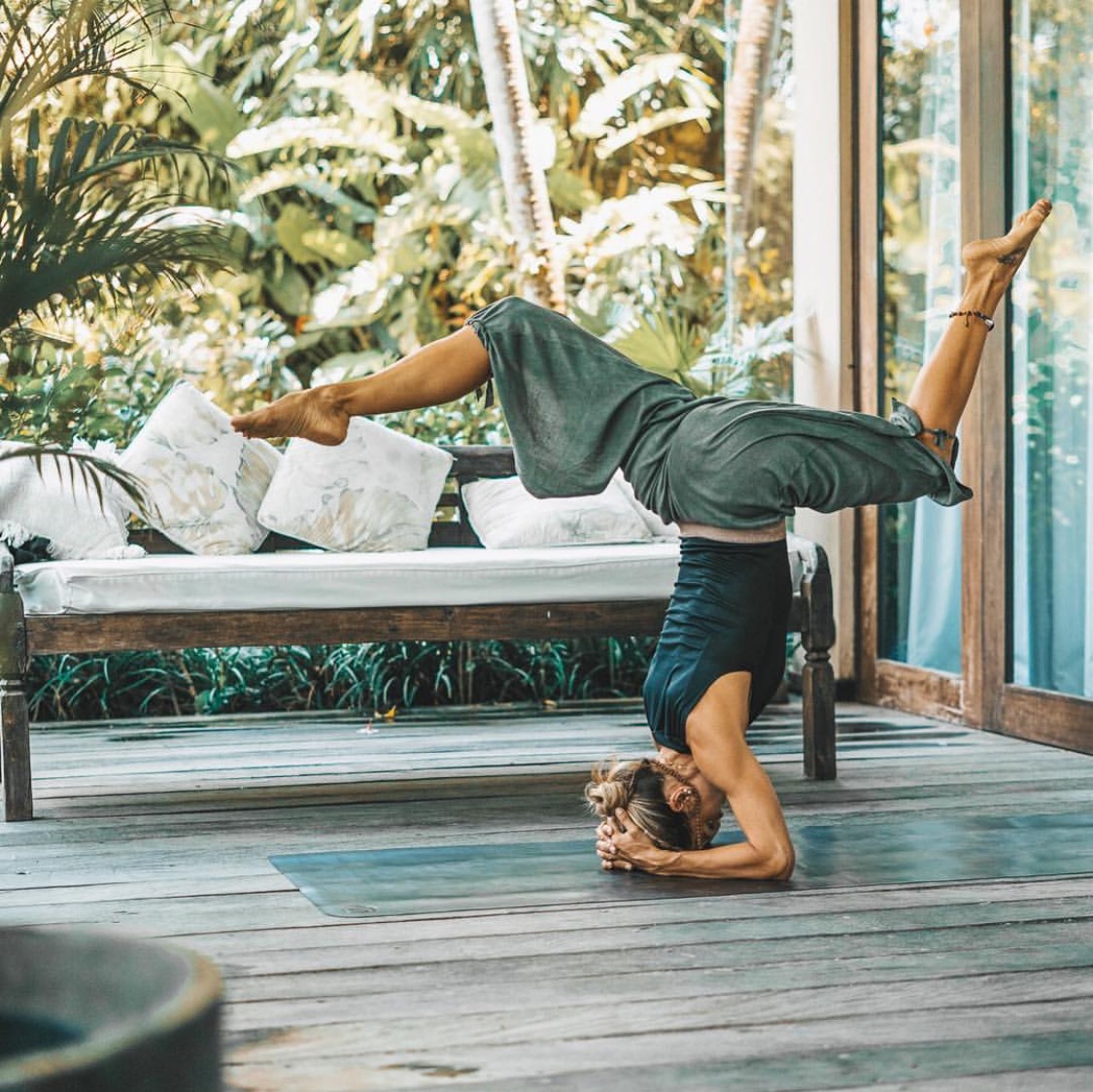
Yoga works for people. But not in the same ways that exercise does. Although researchers are still teasing out the hows and whys of the impact of yoga on the body, we (I dabble a bit in research myself) do have a few good leads.
One way to start looking at why the outcomes are different is to look at how the activities are different. Yoga is different than most exercise programs in a number of ways: intensity, breath, heart rate, relaxation, and more. But the one I want to focus on is inversion.
Get upside down
How much time have you spent upside down today? Unless you have an inversion table or are a fan of silks or gymnastics, the answer is probably close to zero. The body is not used to being upside down. In fact, it has very smartly built in some righting reflexes that help us to maintain an upright position when we find ourselves turned around.
Outside of my yoga practice, the only time I find myself upside down is when I look for my cat under the bed or tie my shoes. But inside my yoga practice is a whole other matter, fraught with lots of irregular situations with gravity.
I firmly believe that being upside down or just being not quite right-side-up has a ton of benefit.”
The risk of inverting
Let’s address the elephant before we put our heads down and legs up. Going upside down can be very risky and it doesn’t have to be. When I say inversion, think about forward bends, downward dog, legs up the wall, and so on. Let’s leave head- and shoulderstand out in the cold for a bit and talk about the good stuff without the bad.
That said, let’s also make a pact now and get on the same foot. Promise me that if your face feels full, tight, and swollen when you’re upside down, you’ll stop. Deal? Deal.
I’m not trying to scare you. Quite the contrary, I firmly believe that being upside down or just being not quite right-side-up has a ton of benefit. But somehow this benefit has become all (full headstand) or nothing (child’s pose), which is the scary part. Truth is that almost everyone can reap the rewards of inversion with minimal risk. Let’s take a look at five things you stand to gain.
1. Heartbreak
Not the ouchy kind but a literal staycation for your heart. Don’t take my word for it – try it. Stand up for a few minutes and then take your pulse for fifteen seconds using a timer. Then sit for a while and do the same. Then repeat this lying down and lastly lying down with your legs propped. Notice anything?
“Promise me that if your face feels full, tight, and swollen when you’re upside down, you’ll stop. Deal? Deal.”
When you are on your back your heart doesn’t have to work so hard against gravity to get blood to the brain. When you have your feet elevated, gravity is assisting the return of blood flow to the heart; therefore, it gets to beat slower. This is why kicking your feet up is a great way to slow down. Even people with high blood pressure can do this on the couch or with their head propped up.
2. Aids Venous Return
The pressure generated by the pumping of the heart and squeezing of the arteries is largely responsible for pushing blood through the veins and back to the heart. The veins have valves, kind of like double doors, that prevent back-flow.
“Allowing the legs to be less upright allows the blood to flow out of the veins without risk of back-flow or obstruction. This is especially important for people who stand all day.”
However, as we age and spend more time standing or cutting off flow (my memaw always told us not to swing our legs and sit on the pickup tailgate) we damage these doors. Allowing the legs to be less upright allows the blood to flow out of the veins without risk of back-flow or obstruction.This is especially important for people who stand all day.
3. Boosts Mood
Being upside down feels funny – like “haha” funny. Think about kids. It’s not weird to see an adult hold their two-year-old upside down and watch him or her giggle. It is a game changer.
In yoga, we talk about how inversion shifts perspective, and in research, we observe that practices that alter body position (even leaning to the side) outside of the norm are more effective in altering mood. Again, downward dog can do this or legs up the chair can do this. It doesn’t have to be the full monty.
4. Improves Immune Function
Aside from redirecting and streamlining blood flow, being upside down also aids in the flow of lymphatic fluid. Lymph is interstitial fluid containing lots of white blood cells. When we have excess lymphatic fluid, we experience swelling, especially in the extremities. Staying active aids in the movement of this fluid through the lymphatic system and back to the heart so it can reenter the bloodstream.
“During the process of returning this fluid, the lymph nodes assess the lymph and plan to fight any suspected infection. Keeping this system functioning optimally keeps us healthier overall.”
But sometimes activity isn’t enough or it is all one-sided in respect to gravity. Inversion aids in lymphatic flow and function. During the process of returning this fluid, the lymph nodes assess the lymph and plan to fight any suspected infection. Keeping this system functioning optimally keeps us healthier overall.
5. Makes You an Elephant
Well, not literally. Some people say inversions make you smarter, but I’d argue they help you remember more. Memory loss is largely age-related and stress-related, but it is also related to reduced blood flow to the brain. No doubt the brain demands a consistent flow of blood for survival, but occasionally increasing that flow can be a boon to our own personal super computers. Inversions (even really small ones) can keep us clear.
Start Small, But Do Start
So, think about it and give inversion a try in small doses. Downward dog is a great place to start as the legs are not fully inverted and the pose is active; therefore, blood pressure is more readily managed. It can take a while for the blood pressure to adapt to inverting, and when you take a week off from your practice, it can take a bit to get readjusted – so be patient.
Also, consider simply putting your feet up. Lay on the floor with a pillow under your head (yes!) and another one under your hips. Then put your calves on a chair. The legs don’t need to be straight. Start with a small session, maybe three to four minutes, and see how you feel.
Click here for our top recommended fitness and health supplements





